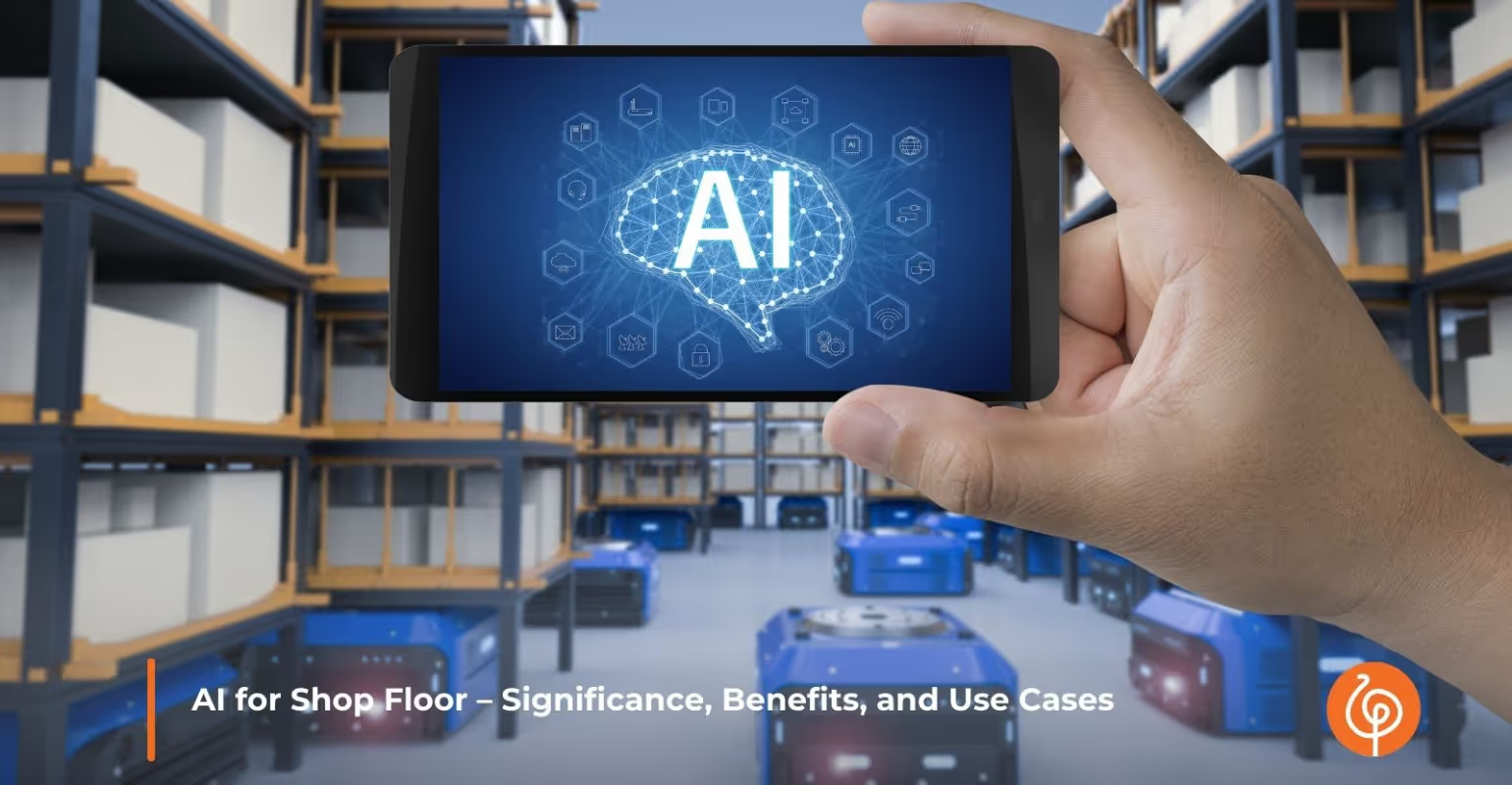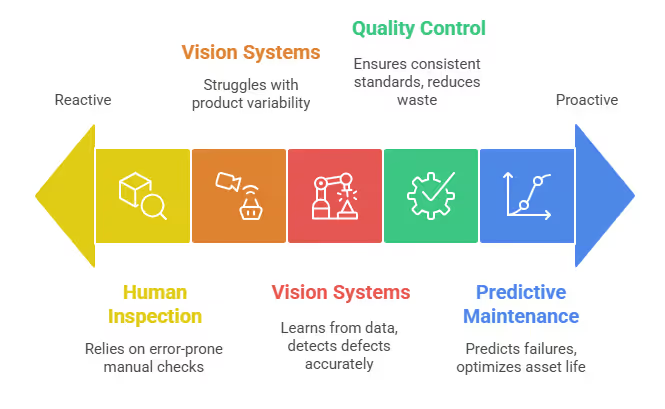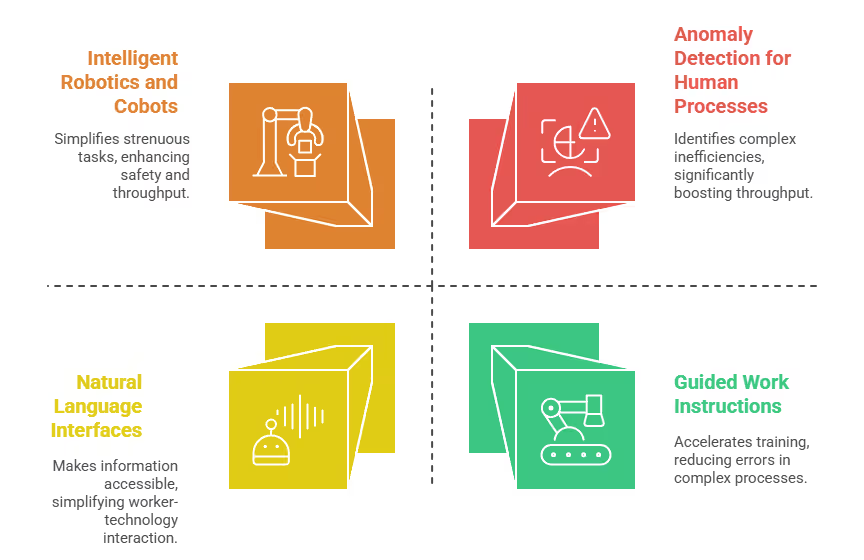AI Shop Floor Assistants – Better Control on the Factory Floor

AI Shop Floor Assitants: Driving a 15% Profit Boost for American Manufacturing
In 2024, over 70% of manufacturing executives in the United States reported that integrating advanced technologies, especially Artificial Intelligence (AI), is critical for their company's future competitiveness. This isn't just about buzzwords; it’s about tangible improvements: reducing downtime by 25%, boosting quality by 10%, and making smarter decisions 30% faster.
For an AI development company working with diverse industries across the US, we've seen firsthand how AI for shop floor applications can dramatically redefine productivity and profitability for American manufacturers, leading to average profit increases of 15%.
AI for shop floor operations is transforming US manufacturing by enabling predictive maintenance, optimizing production flows, and empowering workers with real-time insights for enhanced efficiency and quality control, leading to an average 15% profit increase.
Table of Contents
- AI Shop Floor: Driving a 15% Profit Boost for American Manufacturing
- Why American Manufacturers See a 15% Profit Increase with AI
- How Predictive Maintenance and AI-Driven Quality Control Cut Costs by 20%
- AI Shop Floor Assistants: Boosting Worker Productivity by 20%
- Shop Floor Optimization: Increasing Throughput by 10%
- AI for Construction Estimating: Cutting Bid Prep Time by 70%
- Enhancing Shop Floor Safety with AI: Reducing Incidents by 40%
- AI in Workforce Training: Boosting Skill Acquisition by 35%
- Comparison of AI Application Areas on the US Shop Floor: Quantifying the Gains
- People Also Ask
Why American Manufacturers See a 15% Profit Increase with AI
The landscape of manufacturing in the United States is rapidly evolving. Rising labor costs, the drive for reshoring, and the critical need for greater supply chain resilience are pushing companies to find innovative ways to optimize their production lines. This is where AI steps in, offering capabilities that traditional automation simply cannot match. Our team has spent years observing and implementing AI solutions, from small family-owned factories to large automotive plants in states like Michigan and Ohio, and the impact is consistently profound, often resulting in double-digit profit increases.
One of the biggest shifts we've observed is how AI moves beyond simple automation to enable true intelligence at the operational level. It's not just doing tasks; it's learning, adapting, and predicting. This means a smarter, more agile shop floor that can respond to challenges and opportunities in real-time, directly contributing to your bottom line.

How Predictive Maintenance and AI-Driven Quality Control Cut Costs by 20%
Unplanned machine downtime drains millions from US manufacturers annually. For instance, the Institute for Supply Management (ISM) reported that unscheduled downtime cost the world's 500 biggest companies $1.4 trillion in 2024, with the automotive industry facing per-hour costs of $2.3 million.
This is where AI's predictive capabilities shine, cutting maintenance costs by 10-20% and boosting uptime by 25%.
The Power of AI in Predictive Maintenance
Imagine a machine telling you it needs maintenance before it breaks down. AI, through sensors and advanced analytics, makes this a reality. By continuously monitoring vibration, temperature, current, and other operational data, AI models can detect subtle anomalies that indicate impending failure.
This proactive approach ensures smoother operations and extends the lifespan of expensive equipment.
- Real-time Sensor Data Analysis: AI algorithms analyze data streams from IoT sensors embedded in machinery, identifying patterns that precede mechanical failures with 90% accuracy.
- Reduced Downtime: Maintenance can be scheduled precisely when needed, during planned downtimes, rather than reactively, preventing costly interruptions and reducing unplanned downtime by up to 25%.
- Optimized Asset Life: By understanding wear and tear patterns, AI helps fine-tune machine usage, ensuring assets last longer and perform better, potentially extending asset lifespan by 15%.
AI-Driven Quality Control for Consistent Products
Maintaining consistent product quality is non-negotiable for American brands. Traditional quality control often relies on human inspection or rule-based vision systems, which can be prone to error or struggle with variability.
AI-powered vision systems, however, learn from vast datasets of product images, identifying defects with remarkable accuracy, improving overall quality by 10%.
- Automated Defect Detection: Deep learning models can analyze images of products on the assembly line to spot even microscopic flaws invisible to the human eye. This is particularly valuable in industries like electronics manufacturing.
- Consistent Standards: Unlike human inspectors who can experience fatigue, AI systems apply consistent quality parameters, leading to highly reliable quality assurance processes with a 95% consistency rate.
- Reduced Waste: Early detection of defects minimizes scrap and rework, leading to significant material and energy savings, often reducing material waste by 10-15%.
AI Shop Floor Assistants: Boosting Worker Productivity by 20%

The idea of robots taking over jobs often sparks concern among US workers, but the reality on the American shop floor is far more collaborative. AI shop floor assistants are not replacing human workers; they are augmenting their capabilities, taking over repetitive, dangerous, or data-intensive tasks, and freeing human employees to focus on more complex, strategic, and creative work, boosting overall worker productivity by an average of 20%.
One clear example is the integration of AI into Computer-Aided Manufacturing (CAM) systems. An AI-driven copilot can analyze 3D models and suggest toolpaths, accelerating the creation of CNC programs by up to 40% and simplifying complex machinery programming through natural language processing. This doesn't eliminate the need for skilled CNC experts but significantly speeds up their work and makes advanced tools more accessible.
Key Applications of AI Shop Floor Assistants Boosting Efficiency:
- Intelligent Robotics and Cobots: Collaborative robots (cobots) equipped with AI can perform physically strenuous or monotonous tasks, such as lifting heavy parts or precise assembly, working safely alongside human operators. This enhances worker safety by 30% and increases overall throughput by 18%. For example, Universal Robots reported a 25% increase in production efficiency for Processed Metal Innovators (PMI), a Wisconsin-based metal fabricator, using their cobots for machine tending.
- Guided Work Instructions: AI-powered systems can provide real-time, context-aware work instructions to operators, reducing errors by 15% and accelerating training for new hires by up to 50%. Imagine an AI overlay guiding an assembly worker at a Boeing plant through a complex sequence, highlighting critical steps or potential issues.
- Natural Language Interfaces: Generative AI, with its ability to converse in a human-like way, is bridging the gap between people and technology. Workers can interact with maintenance manuals, production data, and even complex machinery using simple voice commands or text inputs, making information 20% more accessible and processes more intuitive.
- Anomaly Detection for Human Processes: AI can analyze human actions on the shop floor to identify inefficiencies or safety risks. For example, if a worker repeatedly performs an unusual movement to operate a machine, AI can flag this as an anomaly, prompting a review of the machine's ergonomics or a potential maintenance issue that the worker hasn't formally reported. Praxis AI highlighted an automotive supplier in Ohio that doubled throughput on a production line by using AI to identify high spikes in cycle times at certain workstations, leading to a 100% improvement in that segment.
Shop Floor Optimization: Increasing Throughput by 10%
True shop floor optimization hinges on making informed decisions, and that requires comprehensive, real-time data. AI excels at processing vast amounts of operational data, identifying hidden patterns, and generating actionable insights that human analysis alone would miss, leading to an average 10% increase in throughput.
From energy consumption to production schedules, AI provides a holistic view, enabling US manufacturers to continuously fine-tune their operations for maximum efficiency and cost savings.
- Resource Efficiency: AI algorithms analyze energy usage, material consumption, and production schedules to recommend optimizations that reduce waste and save money. For example, GE Vernova's AI strategy focuses on optimizing energy use; dynamic adjustments of lighting, temperature, and machine operations based on real-time usage patterns can reduce energy consumption by 5-10% in manufacturing plants.
- Supply Chain Streamlining: For complex US supply chains, AI offers real-time visibility into supplier performance, logistics, and inventory. By forecasting demand with 85% accuracy, suggesting reliable vendors, and optimizing delivery routes, AI enhances supply chain resilience and reduces costs by up to 12%.
- Production Flow Optimization: AI can identify bottlenecks, predict demand surges, and dynamically adjust production parameters to maximize yield and minimize idle time. This agility allows American manufacturers to adapt quickly to market changes and unexpected disruptions, fulfilling commitments reliably and increasing production efficiency by 7-15%. For example, Rockwell Automation's FactoryTalk ProductionCentre MES, enhanced with AI, helps US factories achieve these gains.
- Digital Twins: Creating virtual replicas of physical assets, processes, or even entire factories (digital twins) allows manufacturers to model, forecast, and manage operations in real-time. Before implementing physical changes, companies can experiment virtually, reducing risks by up to 30% and accelerating innovation cycles. A major automotive OEM in Detroit, Michigan, used a digital twin of their factory to simulate and optimize production, ensuring high throughput from day one and reducing new line setup time by 15%.
AI for Construction Estimating: Cutting Bid Prep Time by 70%
While our primary focus is on the manufacturing shop floor, it's worth noting how AI's predictive and analytical power extends to related industrial sectors in the USA. For instance, AI for construction estimating is rapidly transforming how bids are prepared, significantly improving accuracy and speed, often cutting bid preparation time by 70%.
Traditionally, construction estimating is a laborious, manual process prone to human error. AI-powered tools are changing this by automating quantity takeoffs, analyzing blueprints, and even predicting material costs based on historical data and market trends.
How AI Streamlines Construction Estimating for US Contractors
- Automated Takeoffs: AI can quickly analyze architectural plans and drawings, automatically detecting and measuring project spaces and features, a process that can take hours or even days manually. Software like Togal.AI, used by firms across the US, claims to make takeoffs 80% faster with 98% accuracy on floor plans.
- Error Reduction: By eliminating manual data entry and calculations, AI minimizes costly human errors in estimations, leading to more precise bids and reducing bid rework by 20%.
- Data-Driven Cost Prediction: AI models can analyze vast datasets of past projects, material prices, and labor costs to provide highly accurate cost predictions, helping contractors win more bids. This can improve bid win rates by 5-10%.
- Real-time Collaboration: Cloud-based AI estimating tools allow multiple team members to work on the same takeoff in real-time, improving coordination and efficiency by 25%.
While seemingly distinct from the manufacturing shop floor, the underlying principles of AI — data analysis, pattern recognition, and predictive modeling — are equally transformative, demonstrating the broad applicability of artificial intelligence across industrial operations in the U.S.
Enhancing Shop Floor Safety with AI: Reducing Incidents by 40%
Worker safety is a paramount concern for US manufacturers, with OSHA reporting over 2.8 million nonfatal workplace injuries and illnesses in private industry in 2022. AI is now playing a crucial role in preventing accidents and creating safer environments, with some implementations leading to a 40% reduction in safety incidents.
Artificial intelligence shop floor operations are leveraging advanced sensors and machine learning to proactively identify hazards and prevent injuries before they occur. This isn't just about compliance; it's about protecting valuable human capital and reducing the direct and indirect costs of accidents, which can run into millions for large facilities.
AI's Direct Impact on Safety Metrics:
- Hazard Detection and Alerting: AI-powered computer vision systems monitor production floors in real-time, detecting potential hazards like spills, unauthorized access to restricted areas, or improper use of machinery. For example, Chooch AI's vision systems can identify smoke or flames early, often before traditional detectors, significantly reducing response times in US warehouses. They also alert forklift operators if they approach pedestrians too quickly, cutting collision risks.
- PPE Compliance Monitoring: Ensuring workers consistently wear Personal Protective Equipment (PPE) is critical. AI systems can automatically detect if workers are missing hard hats, safety glasses, or other required gear in designated zones. This automated monitoring helps enforce safety protocols, leading to an 80% improvement in PPE compliance in monitored areas.
- Predictive Safety Analytics: By analyzing historical incident data, near-miss reports, and operational parameters, AI models can predict areas or times when safety risks are highest. This allows US factories to implement targeted interventions, such as adjusting shift patterns or increasing supervision in specific zones.
- Ergonomics and Workstation Optimization: AI can analyze worker movements and postures during tasks to identify ergonomic risks. This data helps design safer workstations and refine work processes, reducing musculoskeletal injuries. For instance, an automotive parts manufacturer in Indiana used AI to analyze assembly line worker movements, leading to workstation redesigns that reduced strain-related injuries by 18%.
AI in Workforce Training: Boosting Skill Acquisition by 35%
The rapid adoption of advanced technologies, especially AI, demands a skilled workforce. However, a 2023 Boston Consulting Group (BCG) study found that only 14% of frontline workers in the US reported receiving AI upskilling, compared to 44% of leaders. AI is now addressing this gap, transforming how American manufacturers train their employees, leading to a 35% boost in skill acquisition and 50% faster onboarding.
AI for shop floor environments is making training more engaging, personalized, and efficient, ensuring that the US workforce is ready for the factories of tomorrow.
This is critical for maintaining competitiveness and adapting to new production methods.
How AI Elevates Training Effectiveness:
- Virtual and Augmented Reality (VR/AR) Training: AI-powered VR and AR simulations provide immersive, hands-on training experiences without the risks of real-world equipment. Workers can practice complex procedures, troubleshoot machinery, and respond to simulated emergencies in a safe, controlled digital environment. Metaverse Learning offers advanced manufacturing programs using immersive virtual scenarios, aiming to boost understanding and confidence. This can reduce training time by 30% for complex machinery.
- Personalized Learning Paths: AI platforms can assess individual worker skills and knowledge gaps, then tailor learning modules to their specific needs. This ensures employees receive relevant training efficiently, accelerating skill development. For example, an AI system used by a heavy equipment manufacturer in Illinois developed personalized training modules for new technicians, reducing their time to proficiency by 40%.
- Intelligent Tutoring Systems: AI chatbots and virtual assistants act as on-demand trainers, answering questions, providing immediate feedback, and guiding workers through complex tasks. This "always-on" support helps reinforce learning and reduces the burden on human trainers. Hitachi uses AI to generate training videos simulating real-life scenarios, transferring expert skills to younger workers and mitigating the impact of mass retirements.
- Performance Monitoring and Feedback: AI can monitor worker performance during training and real-world tasks, identifying areas where further instruction is needed. This data-driven feedback loop allows for continuous improvement of training programs. Companies using such systems have reported a 15% increase in task completion accuracy after AI-driven feedback.
Comparison of AI Application Areas on the US Shop Floor: Quantifying the Gains
To illustrate the diverse impact of AI across the manufacturing shop floor in the US, here's a comparative overview of key application areas:


